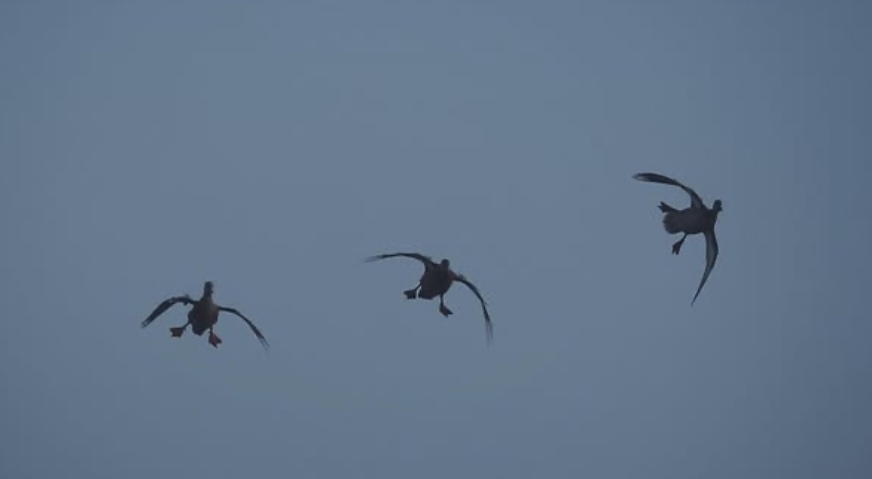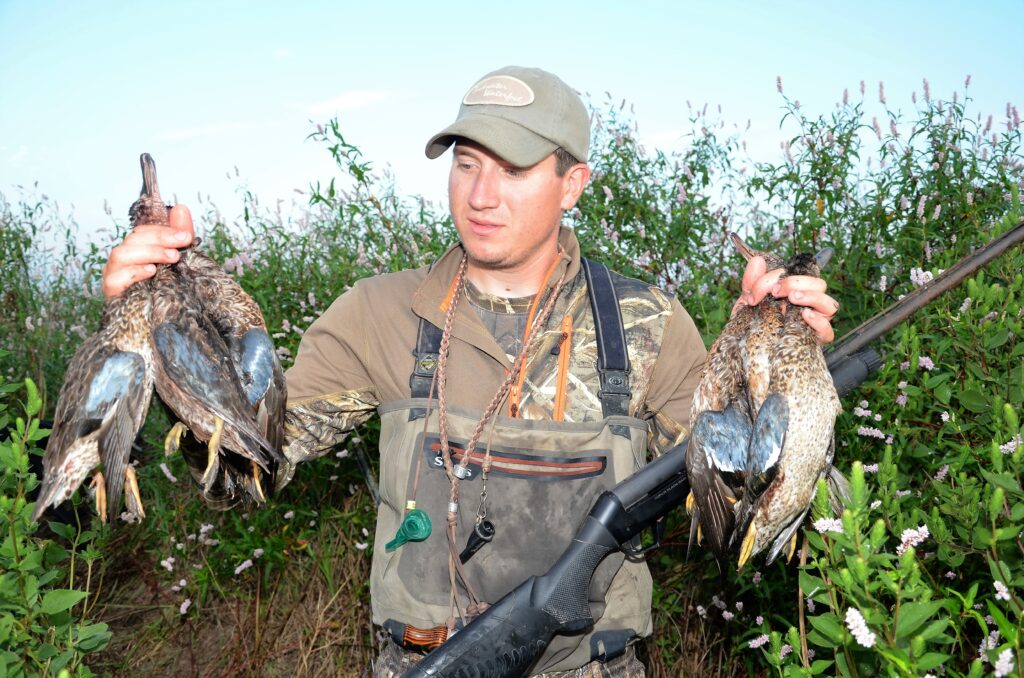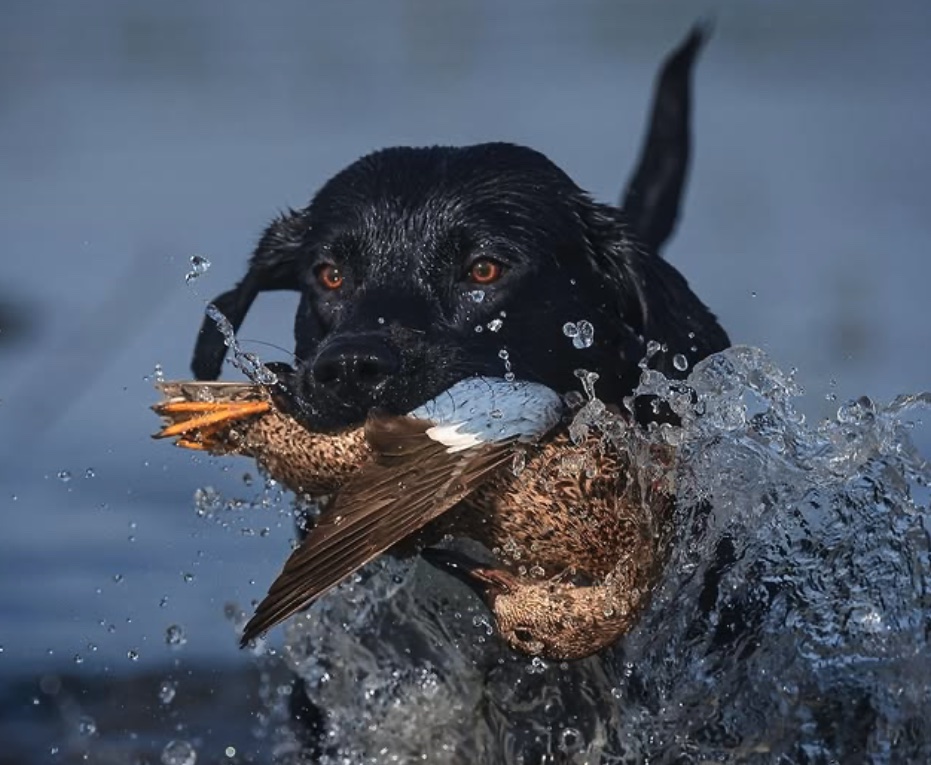Tactics
National Deer Association’s 5 Top Tips for Late-Season Deer Hunting
December 17, 2025 •iSportsman Staff
September 17, 2025
Already sweating from the humid heat, we crouched in tall reeds lining a marshy pothole as unseen specters of teal rocketed low over us in the darkness. Loaded and ready to go, we counted down the minutes to legal shooting hours. Then, distant gunfire rumbled over the marshes. Almost as if on cue, a roaring feathered squadron zoomed over the grass tops, turned and began to settle into the decoy spread.
“Time! It’s shooting hours. Take’em!”
Thus, began a new waterfowl season, or more appropriately, a new waterfowl preseason on this magical September morn. For many waterfowlers, the September teal season kicks off another fall afield. This “preseason warmup” allows sportsmen to get back into the hunting habit, hone their marksmanship and enjoy exhilarating action.
“The September season offers a really good opportunity to get out, get the shotgun dusted off and get back on the water,” opined Seth Maddox, an Alabama Division of Wildlife & Freshwater Fisheries biologist. “It’s fun to get out there early and hunt these birds. They make great tablefare.”
A harbinger of fall, blue-winged teal migrate much earlier than most other ducks and fly longer distances. The diminutive birds primarily winter in Mexico, Central America or South America. Therefore, they start their southern trek earlier than birds wintering in California or the southern United States. Blue-wings normally arrive on the Gulf Coast by early September.
“Blue-winged teal migrate based upon the photoperiod, the amount of daylight in a 24-hour period,” Maddox explained. “When the sun starts to set earlier and blue-wings feel the first cold front on their northern breeding grounds, they get the push to head south.”
By the time many states open their regular waterfowl seasons, most blue-wings have already passed through to points farther south. To increase the harvest on these swift birds, the U.S. Fish and Wildlife Service allows selected states to hold special September teal seasons.
“Some hunters bag blue-winged teal in January, but most teal pass through in September and head farther south,” commented Houston Havens, a Mississippi Department of Wildlife, Fisheries & Parks biologist. “Teal go to the Gulf Coast, but might continue to Mexico, Central America or South America.”

September offers waterfowlers the first chance to get back on the water with early teal seasons. Patrick “Buzz” Hayes Photo
All waterfowl look drab in September before they grow their colorful breeding plumage. Although the season targets blue-winged teal, which normally make up about 95 percent of the September harvest, waterfowlers can also bag green-winged teal.
“Green-winged teal have a different migratory strategy than blue-wings,” Maddox advised. “Green-wings can handle colder weather better than blue-wings. Blue-wings want to get out fast before the weather turns cold and aren’t heavily hunted during the regular season.”
Some states also allow sportsmen to bag cinnamon teal in September. These colorful birds breed in western states or southwestern Canada and typically winter from central Texas to California and down into Mexico or farther south. In September, cinnamon teal and blue-wings all resemble hen blue-winged teal.
“During the September season, it’s very difficult to tell a blue-wing from a cinnamon teal,” said Lance Stancik with the Pintail Hunting Club near Garwood, Texas. “In September, someone might kill a cinnamon and never know it. During the regular season, we shoot a few cinnamon teal. We kill a few green-wings in September.”
Teal hunters might spot other waterfowl not legal to shoot in September. In timbered areas, waterfowlers commonly see nonmigratory wood ducks. Some states allow sportsmen to shoot wood ducks during the September season, so check the regulations first and never pull the trigger without positively identifying the target.
“All ducks lack color in September,” reported Jason Olszak, a Louisiana Department of Wildlife & Fisheries biologist. “Blue-wings have bright blue wing patches, which are excellent field marks in flight. A shoveler also shows blue wing patches, so look for the big spoon-shaped bill. About 45 percent of the September blue-winged teal harvest in the Mississippi Flyway and about 23 percent of all teal shot nationwide in September occur in Louisiana.”
In salt marshes from the Gulf Coast to South Carolina, sportsmen might also see non-migratory mottled ducks. Look for white under broad wings. In September, sportsmen might also encounter a few wigeons, gadwalls, pintails and other ducks.
“Several other duck species also migrate by the photoperiod including gadwalls,” Maddox said. “Gadwalls start coming down when the daylight length gets shorter.”
Black-bellied and fulvous whistling ducks breed in the southern United States and winter in Mexico or farther south. In recent years, black-bellied whistling ducks expanded their range northward and eastward, becoming increasingly common in some areas.

Teal will come in like fighter jets making for challenging shooting. Patrick “Buzz” Hayes Photo
Fast and tremendously agile, teal habitually fly extremely low just over the grass at first light. Unlike mallards, low-flying teal regularly just fall from the sky to crash-land wherever they choose. Even the most experienced waterfowlers might not see them coming. Often, teal seemingly materialize swimming in the decoys, and nobody saw them land.
“Teal don’t really circle,” said Jeff Dauzat of Fin and Feather Guide Service, who hunts the Mississippi River delta marshes south of New Orleans. “They twitter along over the marsh, see the decoys and dive-bomb in. It’s not like trying to work a mallard that circles and circles and never commits.”
To hunt teal successfully, sportsmen must first find them. That requires frequent and extensive scouting. Teal can appear and disappear overnight. One day, swarming clouds of teal buzz a particular pond. The next weekend, sportsmen only see empty skies. On public land, scout several good places in case other hunters get to the prime spot first or if teal prefer another place.
“Teal don’t like confined habitats,” Olszak said. “People won’t find them in flooded timber. They like shallow, open water.”
Small birds, teal don’t require much water. A hard rain could turn a dry field into a teal paradise overnight. A freshly flooded agricultural field with just a few inches of sheet water makes ideal teal habitat. In a great spot, skilled shooters could head home with limits even before the sun cracks the horizon.
“Blue-winged teal eat aquatic vegetation and invertebrates in the water,” Maddox remarked. “They dabble like other ducks, but are smaller, so they need shallow water to feed. They can only get down about six inches deep to feed.”

A lucky hunter shows off a brace of blue wings. John N. Felsher Photo
Going where teal already want to go could mean abandoning comfortable permanent blinds. Fortunately, teal hunters don’t need much cover. Many sportsmen simply hide in high reeds or any other available natural cover.
In marshes, waterproof shell buckets keep extra ammo and other gear dry while providing good seats. In soggy marshes, bring a small piece of plywood as a base and sit on the bucket or a small folding stool. If birds keep landing on the far side of the pond or next pond over, quickly grab the gear, a few decoys and hide at the other spot if that’s where teal want to go.
“Hunting teal in September is much easier than hunting other ducks later in the year,” Stancik confirmed. “People can get away with a little bit more in teal season than in regular season.”
On lakes, marshes or river systems, many people use boats with pop-up blinds for scouting and hunting. Sportsmen can select a spot, toss out a few decoys and begin hunting in minutes. They can even move several times in a morning.
“At Reelfoot Lake, teal are just passing through in September,” observed Billy Blakley with Blue Bank Resort near Hornbeak, Tennessee. “When teal come down, the first thing they look for are lily pad patches. During the regular season, we usually hunt out of permanent blinds, but in September, we use boat blinds because hunters really need to be more mobile to keep up with the teal.”
Teal hunters don’t need huge decoy spreads. Teal will come to any decoy. However, leave brightly-colored mallards home in September. Use small blue-wing or green-wing teal decoys. Since all ducks look drab in September, use mostly hens. Just a few decoys in a good pothole will suffice if it looks natural and what birds expect to see.

A lab at Honey Brake Lodge retreives a blue-winged teal. Patrick “Buzz” Hayes Photo
Leave the mallard quackers at home. Blue-wing drakes make a whistling tsee tsee sound. Hens make a high-pitched squeal. Drake green-wings make a high-pitched preep-preep. Hens make a sharp, high quack, a warning sound. In the right spot, no calling works better than bad or wrong notes.
“In some places, people don’t even have to call because teal already want to go there and just show up,” said Canaan Heard with Faulk’s Game Calls in Lake Charles, Louisiana. “Hit a few notes and then stop. If teal turn toward the decoys, stop calling.”
In the Deep South, temperatures can quickly exceed 90 degrees in September. In places with alligators, the big reptiles remain very active. In some places, gators learn to associate gunfire with feathered food falling from the sky. Sometimes, gators lurk just outside the decoys waiting for breakfast. For this reason, most hunters in gator country leave their retrievers home during September.
Despite the heat and the alligators, this truly special season gives sportsmen excellent opportunities to make new memories and polish their skills. Just do the scouting, dress for the season, drink plenty of liquids, watch for gators and carry lots of insect repellent to enjoy these magical September mornings.
 John N. Felsher is a professional writer, broadcaster, photographer, editor and consultant. An avid sportsman, he’s written more than 4,000 articles for more than 176 different magazines on a wide variety of outdoors topics. He also hosts an outdoors tips show for WAVH FM Talk 106.5 radio station in Mobile, Ala. Contact him at j.felsher@hotmail.com or through Facebook.
John N. Felsher is a professional writer, broadcaster, photographer, editor and consultant. An avid sportsman, he’s written more than 4,000 articles for more than 176 different magazines on a wide variety of outdoors topics. He also hosts an outdoors tips show for WAVH FM Talk 106.5 radio station in Mobile, Ala. Contact him at j.felsher@hotmail.com or through Facebook.
